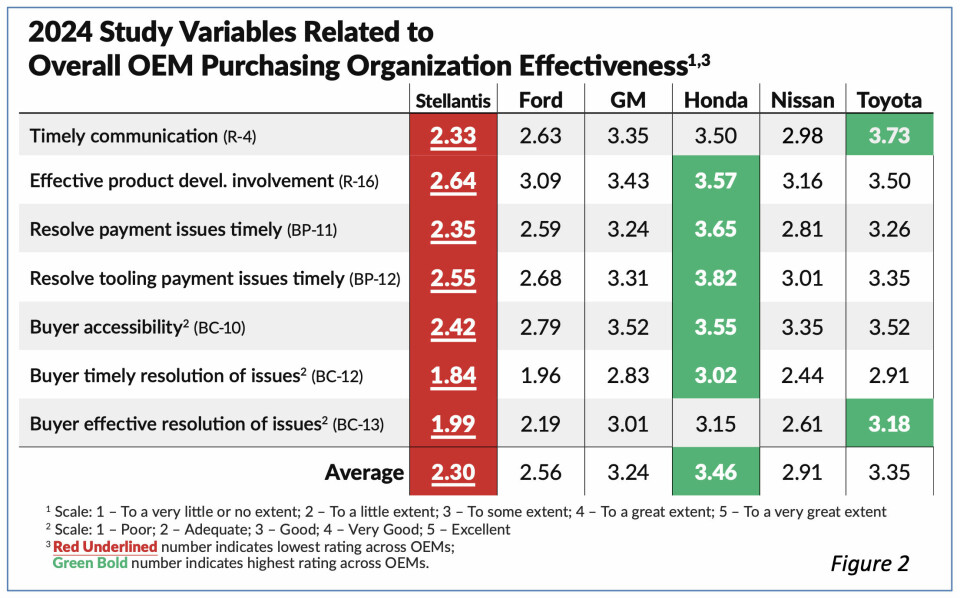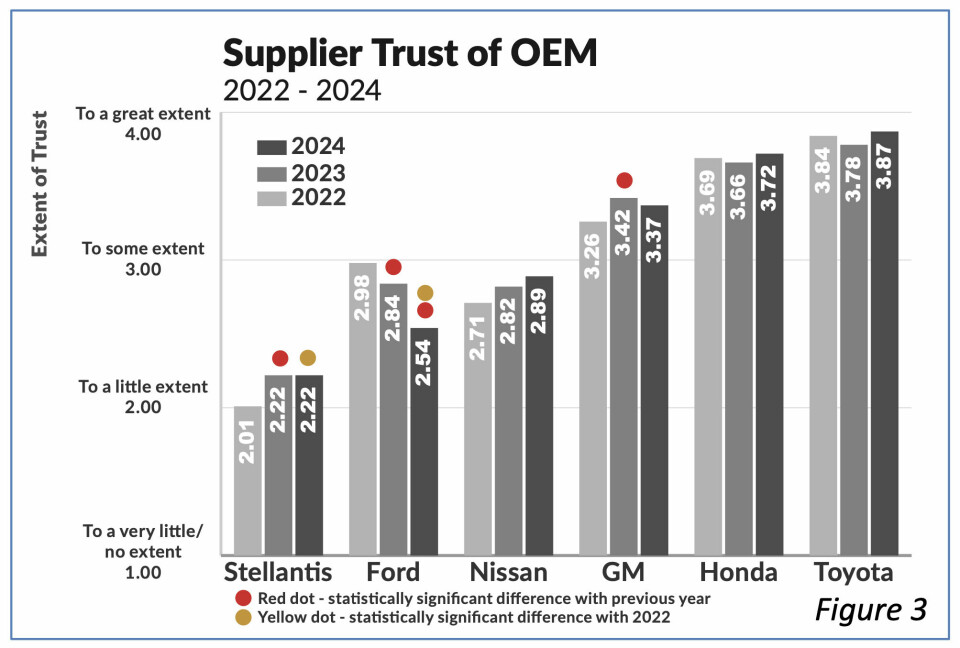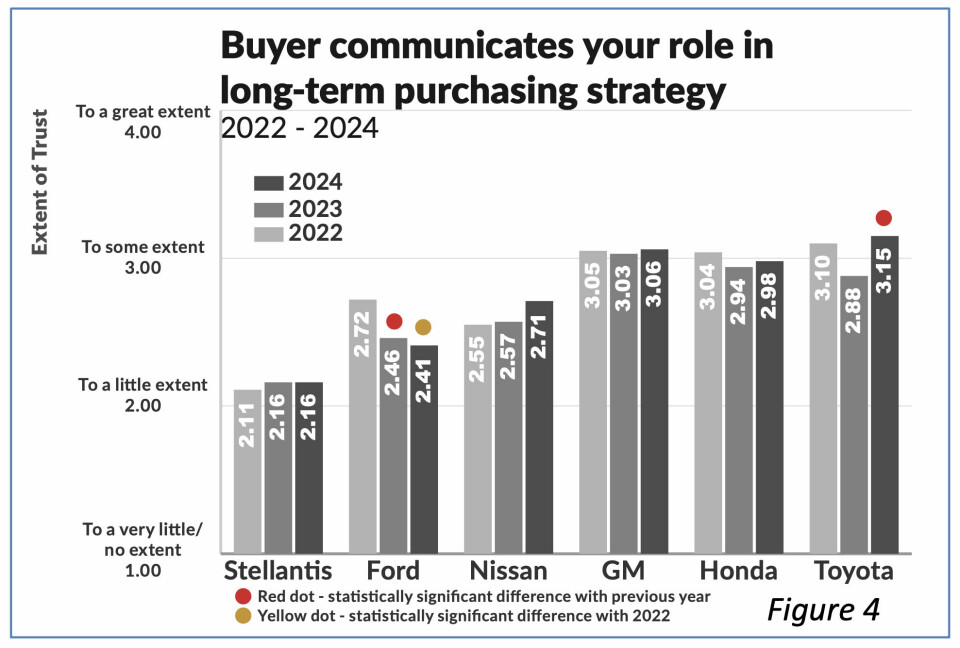Sharing risk drives supplier relations for GM, Stellantis, Honda, Nissan
The key driver in improving supplier relations is sharing risk and cost in an equitable way, according to an annual study by Plante Moran.
The study, now in its 24th year, found that supplier relations had improved for Honda, GM, Nissan and Stellantis in the past year, despite strains on the supply chain, beause of this sharing of risk.

Despite Stellantis’ continuous improvements over the past two years, it remained at the bottom of the pile in the North American Automotive OEM Supplier Working Relations Index (WRI), at 152 points. The study ranks OEMs based on their commercial relationship with suppliers, through perceived trust, timely communication, mutual profit opportunity, assistance and a reduction in communicatoin friction.
The only OEM in the study, which collected responses from 696 supplier executives from 429 tier one suppliers, to go down in supplier relations was Ford. For the second year running, Ford’s scores dropped, from 242 points in 2022 to 197 this year.
Dave Andrea, principal, Strategy and Automotive & Mobility Consulting, Plante Moran, said that a balance of sharing risk and cost while relentlessly pursuing cost reduction is the biggest factor in OEM supplier trust.
“With all the challenges and conflicts facing suppliers this past year, it’s not surprising that some automakers dropped even further in their scores. But what might be surprising to some is that several automakers improved their scores significantly during the past year.”
Andrea said this shows that piece price economics alone are not what drives the automakers’ score. “The score also reflects the tangible and intangible costs to serve the OEMs,” he said. “The primary driver behind the largest WRI point gains is sharing risk and cost in an equitable manner while relentlessly pursuing cost reduction. This will enhance the mutual long-term financial and innovative capability of the customer and the supplier. OEMs doing this best integrate their suppliers into their corporate strategy and keep WRI-related principles front and centre in their dealings.”
OEMs need to revise contracts
One of the key takeaways from the study was that carmakers need to revise outdated contract terms and conditions, and purchasing practices built over decades for the new realities of the EV transition and beyond.

There is a need for more flexibility, particularly when suppliers are dealing with unused capacity because of delayed programmes. Andrea said that contract structures need to be updated to deal fairly with the risks inherent in transitioning to EVs, adopting new technologies, sourcing new materials and amdist increasing competition from China.
“In uncertain, high-risk times there needs to be more trust, transparency and flexibility, not less,” Andrea said. “Fixed terms and conditions must be restructured to deal with new market conditions.”
This is something that we’ve heard from several OEMs recently, particularly in Europe, including VW Group. At Automotive Logistics and Supply Chain Europe, which took place in March, Oliver Bronder, managing director vehicle logistics at VW Group Logistics said transparency is extremely important in the supply chain, including providing better production forecasts for its suppliers and establishing longer-term transport contracts with logistics providers where it made sense, beyond the typical three-to-five-year tenders.
Leadership needs to collaborate to manage supplier risk

Andrea said that corporate leadership beyond purchasing, especially finance and engineering, need to cooperate in managing supplier cost and risk reduction requests. The best OEMs know faster responses and new cost recovery formulas are needed if they expect a strong relationship with suppliers and best efforts on the suppliers’ behalf. In addition, he said that suppliers have a choice as to whom they work with and can make decisions to manage down business with specific OEMs.
BMW has been making this change, having transformed by installing its Programme Commission strategy which brings production, finance, sales, purchasing, and supply chain and logistics under one umbrella.
Under the leadership of Dr Michael Nikolaides, senior vice-president of production network, supply chain management and logistics at BMW Group, the programme is helping to manage the hostile economic environment and is empowered to make strategic decisions across the carmaker’s different business areas. The transformation has been expensive, but Nikolaides said that sometimes the best solution isn’t the cheapest one, and collaboration and partnership can help with this.
OEM demands need to incorporate the price of the relationship
Annual price reduction productivity demands by OEMs need to incorporate the cost of the total supplier relationship, said Andrea. Suppliers and OEMs must look for annual cost reductions through true productivity gains, getting more output with fewer input resources. This takes investment, which comes from adequate returns on investment for suppliers.
”In this uncertain and high-risk business environment, communication is key, because supplier CEOs have an increasing number of OEM customers they can work with”
He said that meaningful cost-reduction suggestions made by suppliers can be evaluated and adopted more quickly by OEMs if, like mentioned above, their design, engineering and purchasing departments are working together.
“This would expedite revalidation of parts using lower-priced materials, reduce complexity and lower parts count by part consolidation,” Andrea said. “Better cost estimating and target pricing by OEMs and suppliers would help correct this.”
Timely communication remains key
Just like last year’s survey, one of the most important factors in improving OEM-supplier relations is improving communication, including sharing information on the OEM’s long-term purchasing strategy on a timely basis. Here the bottom three OEMs match their order in the overall WRI score while the top three are reordered slightly with Toyota first, GM second, followed by Honda.

“All six of the OEMs need to improve in this important area,” said Andrea. “In this uncertain and high-risk business environment, communication is key, because supplier CEOs have an increasing number of OEM customers they can work with. Their decision often comes down to asking and answering three key questions: ‘Who do I trust? Where will I get the best return on investment? And what is the prospect for future business?’ So, it’s in the OEM’s best interest to maintain open and honest communication with its suppliers.”
Again, this also applies to internal communications within the OEM to better align purchasing, engineering and manufacturing divisions.
“There’s no question the industry has run into unprecedented and unexpected challenges in the shift to EVs,” Andrea added. “However, OEMs that effectively address these issues are generally stronger, more profitable and become customers of choice for suppliers.”





